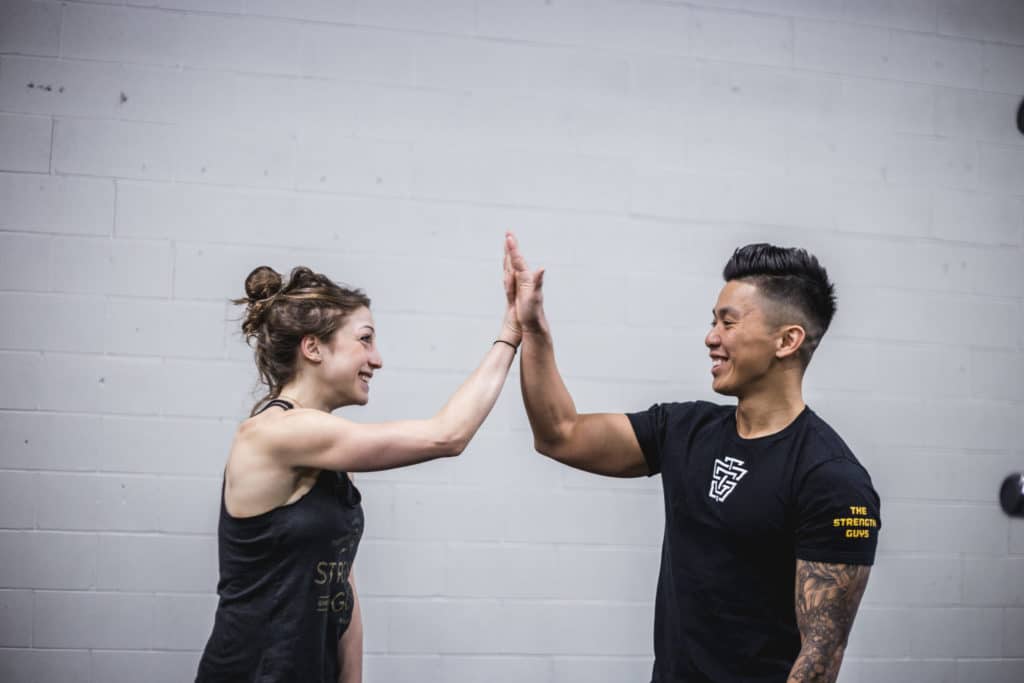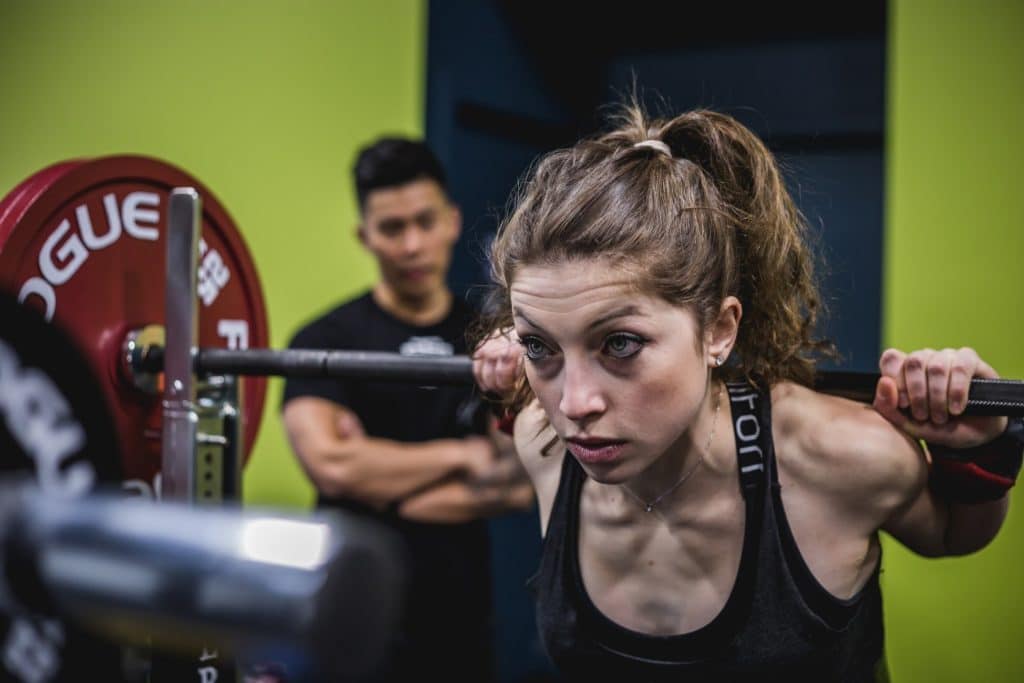9 de February de 2020
4 Questions Answered about Velocity-Based Training
Curious about Velocity-Based Training? Don’t know where to start? We’ve got answers, and as an athlete, I’m here to help you out.

What is the Science Behind Velocity Based Training?
Evidence suggests that the higher the velocity achieved against a given load, the greater the intensity and training effect
Velocity-Based Training (simply put) is a method of athletic training that uses a piece of technology to track the movement speed of a specific exercise. Never heard of it? The use of velocity as a metric within athletics is not new and has in fact been in use for many years. However, due to advancements in technology and information, it is beginning to become more mainstream and accessible. As a result, it is now easily applied to not only elite athletes but also every-day gym-goers and anyone looking for improvements in their training. Everyone can benefit and get results.
Why measure velocity? Evidence suggests that the higher the velocity achieved against a given load, the greater the intensity and training effect (1). Strong relationships have also been observed between velocity loss during lifting and measures of fatigue (2). It provides new data to inform (and optimize!) training and programming, and the prescription of loads and work completed. It provides real-time objective feedback to understand training, estimate strength, monitor training, and develop unique athlete profiles to optimize weight loaded on the bar.
Nicola Paviglianiti is part of the charity Lift4Life, which empowers marginalized communities through strength training and the sport of powerlifting
Who is Velocity-Based Training For?
Velocity-Based Training is for anyone and everyone around the world. While commonly used for barbell sports such as powerlifting and weightlifting, Velocity-Based Training also has benefits for athletes of diverse sports in order to improve performance as resistance training is an effective method for enhancing a variety of sporting tasks – maximal strength, jumping, sprinting – the list goes on.
The application of Velocity-Based Training may be seen as lying on a continuum and can be used with varying emphasis to enhance and inform training (2). At its most basic level, velocity may be utilized in conjunction with traditional training as feedback to enhance performance and improve motivation and competitiveness. To the more advanced level, where velocity may be utilized to establish training and the specific loads used for an exercise.
Athletes
Do you ever go into a workout or training session where everything feels heavy? Should you lower the weight? Or what if everything feels light? Velocity-Based Training provides real-time objective data to inform training decisions and target optimal loading to prevent overloading or underloading. As an athlete, staying away from over-training or injury is key to progress and longevity in any sport. The immediate feedback can also be helpful for athletes to improve performance and motivation, as it encourages competitiveness and promotes intensity through the expression of maximal effort every repetition.

Coaches
Velocity data can be another means for coaches to train athletes and prescribe exercise load, as well as monitor training. Rather than just subjective data from an athlete regarding their training, velocity is an objective data measurement that coaches can use to inform sessions. It can help take the guess work out of an athlete’s training!
With an increase in coaching happening remotely and online whereby the coach is not able to train and be with the athlete in person, velocity can be a unique tool to regulate training and ensure the correct stimulus is used at the time. Coaches can ensure an athlete makes the proper load adjustments on the day when it is needed.
Additionally, Velocity-Based training provides a method of athlete evaluation and testing beyond just the traditionally used 1 repetition maximum (1RM) or performing reps to failure in order to establish loads and athlete improvements. Velocity can be used to estimate 1RM to help assess and inform training. It avoids the problems historically seen with 1RM and percentage-based training as it takes into account day-to-day fluctuations in strength and performance. Additionally, it avoids the time-consuming nature of 1RM testing and the injury risk presented when working close to failure.
Teams
Who doesn’t like some friendly competition! Velocity-Based Training within teams and groups of athletes can be a way to promote competitiveness, and a means to constantly push the collective. It provides motivation to constantly strive to be better than before and in comparison, to other athletes. Even remotely, it can be a tool to establish a competitive atmosphere amongst athletes through the sharing of data. Furthermore, velocity can also be an effective method to test and evaluate teams in order to overcome the limitations and difficulties of 1RM testing in a large group setting.
What is a Load-Velocity Profile? And why is it Important?
No two lifters are alike. Lifter “A” may be very inefficient at moving light loads fast, however, may have good endurance. Whereas lifter “B” may be very efficient at moving loads fast. Speed of movement will also vary based on the exercise in focus.
An athlete’s velocity profile will correlate a specific velocity with a certain % of their 1RM or a specific RPE
Velocity profiling is a promising application of velocity training and allows for an accurate interpretation of athletes’ velocity outputs. A Velocity Profile highlights the inverse relationship of load and velocity for an athlete. An athlete’s velocity profile will correlate a specific velocity with a certain % of their 1RM or a specific RPE. A velocity profile can also highlight individual athlete characteristics and individual strengths and weaknesses. Research has confirmed that the load-velocity relationship can be used to estimate maximal strength performance and 1RM (4). As a result, unique velocity profiles and the gathering of unique athlete data may be used to inform and develop training interventions and load prescriptions to optimize training
While limitations exist and context is always key with many factors impacting training, profiles can be useful in the application of velocity within training. Interested in learning more about velocity profiling? More on Load-Velocity Profiles and how to compare athletes can be found.
How Do I Get Started with Velocity-Based Training?
Purchasing an encoder is your first step to beginning your journey with Velocity-Based training. Vitruve offers an affordable encoder, and a variety of accessories to ensure it can be implemented into training with ease. As Vitruve offers world-wide shipping, every athlete and coach across the globe has the opportunity to get started using velocity within their training.
When you have your hands on an encoder, the next step is to familiarize yourself with the app and device. From securely attaching it to the barbell, to connecting it to an iphone/ipad to gather the data. Outlining goals within your training is key including identifying the data you intend to monitor and progress. Additionally, establishing unique velocity profiles to understand your lifting is crucial to inform training.
Lift fast! In order to get accurate data and results using encoders, it is important that an athlete lift with intention and speed every rep. If you are a team, now is the time to set up a competitive environment. If you are an athlete and have a coach, it is important to communicate and work with them in this process.
Lastly, it’s important to constantly learn and adapt as you improve and train using velocity as a metric. Have fun learning about your lifting and using velocity to inform your training.
You can read more about beginning your journey with VTB and Vitruve on this blog watch this YouTube video about starting with the Vitruve Tracker here.

How are you using Velocity-Based Training and a Vitruve Tracker? Now is an exciting time to be involved in Velocity-Based Training. New advancements and research are continuously unfolding as more coaches, athletes, and teams use incorporating velocity as a metric within training. Let us know how you are using Velocity-Based Training in the comments below or by tagging @vitruvefit on social media!
References
1) González-Badillo, J. J. & Sánchez-Medina, L. (2010) Movement velocity as a measure of loading intensity in resistance training. International Journal of Sports Medicine, 31(5), 347–352. Retrieved from – https://www.thieme-connect.de/products/ejournals/abstract/10.1055/s-0030-1248333
2) Sanchez-Medina, L., & González-Badillo, J. J. (2011). Velocity loss as an indicator of neuromuscular fatigue during resistance training. Medicine & Science in Sports & Exercise, 43(9), 1725-1734. Retrieved from – Fatigue during Resistance Training
3) Weakley, J., Mann, B., Banyard, H., McLaren, S., Scott, T., & Garcia-Ramos, A. (2020). Velocity-Based Training: From theory to application. Strength & Conditioning Journal. Retrieved from – https://www.researchgate.net/profile/Jonathon_Weakley/publication/341554144_Velocity-Based_Training_From_Theory_to_Application/links/5ec6fa75458515626cbf2c56/Velocity-Based-Training-From-Theory-to-Application.pdf
4) Jidovtseff, B., Harris, N. K., Crielaard, J.-M. & Cronin, J. B. (2011) Using the load-velocity relationship for 1RM prediction. Journal of Strength and Conditioning Research, 25(1), 267–270. Retrieved from: https://journals.lww.com/nsca-jscr/Fulltext/2011/01000/Using_the_load_velocity_relationship_for_1RM.38.aspx


